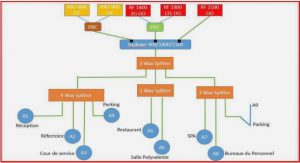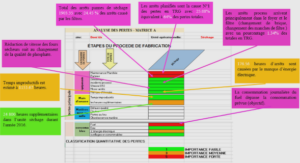Calibrating an IFTS scanning moving scenes
Fourier Transform Spectrometer
A Fourier Transform Spectrometer (FTS) captures the electromagnetic spectrum of a source by measuring the temporal coherence of a radiative source. A beam of light is split into two beams and reflected off two mirrors. At least one of the mirrors is moving to change the optical path difference between the two beams. The reflected beams are then brought together and the amplitude of the interference pattern is measured. An interferogram is measured by sampling the interference pattern for different optical path differences. The Fourier Transform of this interferogram returns the spectrum of the input source. Given a monochromatic source A(σ0), where σ0 is the wave-number (reciprocal of wavelength), the intensity of the interferogram, as a function of the optical path difference (OPD) x between the two beams, is given by It(x) = 2A(σ0)[1 + cos(2πσ0x)] where It(x) is the intensity at a given OPD x.
The zero path difference (ZPD) is the location where the optical path difference is zero, and is the point where the interferogram is maximum. This occurs when both mirrors are equally apart from the beam splitter. At this point the size of the interference pattern is infinite, and the central fringe occupies the entire image plane.
IFTS Data Cube Acquisition
Simulated Data
A simulator has been designed in order to generate data cubes with varying characteristics.
With the simulator, we can simulate target motion with different parameters for the IFTS (several gas spectra, integration area for the detectors, etc.)
The output of the simulator represents an array of detectors of an infrared camera. Each pixel in this camera gives a value related to the integration of the incident light from the IFTS on it. The dimension of this array can be varied.The integration in the detector is implemented by dividing each pixel to 100 sub-pixels then integrating their values. These sub-pixels can be adjusted afterward to put in consideration the area occupied by the electronics in the infrared camera (fill ratio).
The red circles show the loci where the pixels have the same off-axis effect. For simplicity in some of the output generated cubes, the off-axis may be calculated one time only for each pixel location and its value is assigned to all the sub-pixels related to this pixel
Experimental Data
Two sources of experimental data cubes are used in this thesis: from an instrument of ABB Bomem and from SpIOMM (Spectrometre Imageur de l’Observatoire du Mont-Megantic) at Laval University.
ABB Bomem Experimental Data
An IFTS prototype working in the infrared range is used to acquire experimental data cubes at ABB Bomem. A blackbody radiates behind the target and the transmitted radiation is captured by a 16 bit thermal camera. The data cube contains nearly 8000 frames with dimension 64*64. The system is guided by a sinusoidal laser beam at frequency of 15,798 Hz. The detector IR signals are sampled at equal spaced intervals, so we can eliminate the sampling position error.
SpIOMM Experimental Data
SpIOMM is an imaging FTS for astronomy that was assembled in 2004 at Laval University. It was developed in collaboration with ABB Bomem, INO (Institut national d’optique), and the Canadian Space Agency. It is designed to be attached to a telescope for space and galaxy observation. There are successful observing runs using the SpIOMM at the observatoire du Mont Mégantic in southern Québec[16, 15, 11, 12]. SpIOMM operates in the visible range (350-900nm) with a circular field of view of 12 arcminutes in diameter. Its detector is bluesensitive, liquid nitrogen-cooled with spatial resolution of 1340 x1300 pixels. The physics of SpIOMM depends on the classical Michelson interferometer with two outputs ports. One port is only used and the interferogram is recorded by individual images at each OPD step. The interferometer is controlled with a laser-based servo system that is programmed to control the position of the mirror. The interferogram is sampled at a step size determined by the Nyquist criteria. The readout time of the detector is around 5 seconds.frame is supporting the SpIOMM in the vertical direction. To access the field of view, we designed a wood base with a square hole in the center and installed it on the top of the metal support as shown in the right of Figure 2.11. We combine two lamps to form the light source for the experiment: a wide spectrum argon lamp including several peaks at the range of 700nm to 900nm, and a halogen lamp with a continuous spectrum from 300nm to 900nm.
This combination creates a light source with wide continuous background and sharp peaks. We install a resolution target or visible filters in front of the field of view. The light emitted from the lamps is reflected by the ceiling then passed through the filters or the resolution target to reach the camera.
Effect of Motion on the Interferogram and Spectrum
To examine the effect of motion on the interferogram and the spectrum, we consider a scene that is a background of a blackbody at 300K , and a CO2 target at 250K in absorption mode. This scenario represents a carbon dioxide gas at height of 6 km over the earth’s surface which is scanned in front of the surface of the earth. The target moves from the lower right corner to the upper left one in a step of 0.1pixel/frame. We simulate a grid of the output detectors of 128×128 pixels with 1000 frames. The ZPD is at frame 501. We ignore the noise and shear effect while setting a maximum off-axis angle of 0.04 Rad. The output sample is a 16 bit pixel to simulate the infrared camera. The sensor operating band is between 500- 2000 cm−1 wavenumber. The sampling rate is twice the maximum frequency of the input spectrum. We track the interferogram of the pixel located at the border of the CO2 column of gas. We compare this pixel with another pixel in a stationary cube. From the scanned interferogram of the moving target, we recognize that the samples on the OPD are related to the background at the beginning of the scan till the area around the ZPD. The intensity of the background samples is higher than the intensity of the samples of the target because the target is in the absorption mode. Around the ZPD, the samples are related to the CO2, then the samples are related to the background when moving further along the OPD. Most of the information is placed around the ZPD. The far OPD affect mainly the resolution of the spectrum. We
can see the errors (i.e low resolution) in the spectrum obtained from the moving target when compared to the spectrum obtained from the non moving target. The goal is to correct for the motion in order to maintain a useful or a high resolution spectrum representing the target.
Motion Compensation
In order to obtain high spectral accuracy, the scene has to be stationary in the field of view of the IFTS for the complete acquisition time of the data cube. This condition may not be fully met for some applications. Due to the relative motion between the instrument and the scene being scanned, the interferogram of a given pixel is composed of data samples coming from different sub-areas of the scene, leading to corrupted spectra when Fourier transformed.
In airborne FTS imagers, the motion compensation is done using opto-mechanical means to get the interferogram samples from the same spatial location. We propose to perform motion compensation a posteriori using the data information. We use motion estimation techniques to recover the undistorted spectra. This will compensate for the unpredictable motion where the opto-mechanical means fail, and will not add to the hardware complexity.
Review for Motion Estimation Techniques
In this section we review motion estimation techniques, and divide them to two categories according to our data. We fully discuss the techniques that are suitable for our data and discuss the modification if any.
Optical flow has been commonly described as the apparent motion of brightness patterns in an image sequence. Computation of optical flow is known as the problem of estimating a displacement field [dx, dy] for transforming the brightness patterns from one frame to the next in the data cube. It is critical to choose an appropriate constraint equation that accurately represents the significant events in a dynamic scene. Optical flow can be induced by the relative motion between the camera and a scene. However, it may also exist, in the absence of camera and/or scene motion, due to other events such as a light source .
Recovering the 2-D velocity field from a sequence of intensity images is an ill-posed problem. The problem is ill-posed because local intensity alone fails to completely generate the motion information. For example, in regions of constant intensity, motion cannot be detected and an infinite number of solutions exist. Even when the intensity is constant in a given direction, the solution is still only partially available. Under such conditions, it is only possible to provide the component of the solution that is perpendicular to the given direction. This is referred to as the aperture problem . Because the problem of recovering the 2-D velocity is ill-posed, additional information must be added to the problem statement to clearly define a closed set in which a single stable solution exists.
IFTS output frames are challenging from the point of view of motion estimation techniques. They have a temporal change that is related to the interferogram intensity of the pixels that varies along the OPD axis and can be related to non-uniform illumination problem in the video sequence literature. The interferogram has its maximum at the ZPD, then it decreases to the side-lobes taking the shape of an auto-correlation function. We may divide the methods for motion estimation or optical flow techniques to two categories. The first category is the one that employs brightness constancy, where it is assumed that the image brightness of a scene point remains constant or approximately constant from one frame to the next. The second is that which allows the brightness variation of a surface. The scene dynamical events induce both geometric and radiometric variations in time-varying image. This category is suitable for our data cube where the geometric variation can be related to the relative motion between the instrument and the scene, and the radiometric variation can be related to the interferogram intensity change.
|
Table des matières
1 Introduction
1.1 Applications of Imaging Fourier Transform Spectrometers
1.2 Motivations
1.3 Objectives and Major Contributions
1.4 Thesis Organization
2 Imaging Fourier Transform Spectrometer and Data Cube Acquisition
2.1 Fourier Transform Spectrometer
2.2 IFTS Data Cube Acquisition
2.3 Conclusion
3 Motion Correction
3.1 Problem Illustration for Motion
3.2 Review for Motion Estimation Techniques
3.3 Simulated Data
3.4 Experimental Data
3.5 Conclusion
4 Off-axis Correction
4.1 Illustration and Solving for Non-uniform Off-axis Distortion
4.2 Off-axis Correction for Simulated Data
4.3 Off-axis Correction for Experimental Data
4.4 Conclusion
5 Calibrating an IFTS scanning moving scenes
5.1 Problem description
5.2 Calibrating a Stationary Simulated Cube
5.3 Calibrating an IFTS Scanning Moving Scenes
5.4 Conclusion
6 Conclusion and Future Work
6.1 Contributions
6.2 Future Research Avenues
Bibliography
A Simulator Setup
A.1 Input Spectrum
A.2 Hitran Database
A.3 Multiple Layers Calculations
A.4 Downsampling high resolution spectrum
A.5 Simulator architecture
A.6 Simulation scenarios
B GDIM algorithm modification
B.1 Division using the radiometric multiplication factor
B.2 Partial derivative calculation
![]() Télécharger le rapport complet
Télécharger le rapport complet






